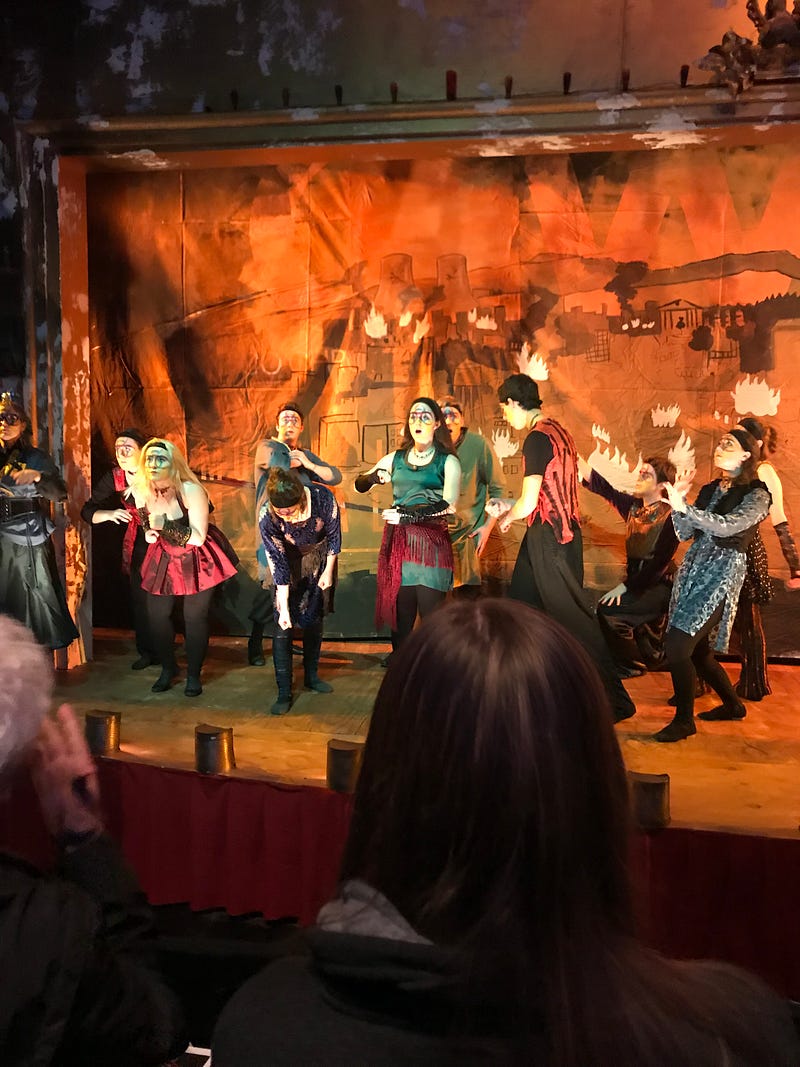
Although the Hamilton College theatre department’s fall mainstage production occurs in a time “post-electricity,” the actors and production team shined on stage last weekend.
Mr. Burns, a post-electric play
, written by Anne Washburn, directed by Craig Latrell and music directed by Karen Corigliano opened this past weekend in the Romano and Barrett Theatres. The play follows characters in a post-apocalyptic society over the course of three acts, as they retell the same episode of
The Simpsons
television show in each act. As the show progresses, the story of the episode, the iconic “Cape Feare,” evolves and takes on a life of its own. The acts take place within both the Romano and Barrett theatres, and the audience moves back and forth between the spaces during the show’s two intermissions.
Act One begins with six characters sitting around a campfire, trying to recount the plot and specific lines of
The Simpsons
episode, “Cape Feare.” It quickly becomes clear they are using this storytelling as a distraction from a recent nuclear apocalypse that has ravaged the country. They are later joined by Gibson, played by Timothy Hartel ’18, another survivor who helps them retell the episode. Gibson’s arrival also prompts more discussion about the recent disaster, a widespread meltdown of nuclear power plants that led to the shutdown of the electrical power grids.
The set design for this scene is unique, as audience members are sat around the campfire with the actors, surrounded by trees. More than that, the primary lighting for the scene comes from the campfire, so while the space is dark and it is often difficult to see the actor’s faces, the effects in the room are chilling. As a result, audience members become one with the performers, as they too are sitting around the campfire. Additionally, audience members are further immersed in the world of the play with the scents of fire, the sounds of crickets and rivers, and the ambiance of the dark blue lighting surrounding the space. With lighting design by Seth Reiser, set design by visiting assistant professor of theatre Sara Walsh, sound design by Jeff Larson, and choreography by Kate Gwydir ’18, the audience is entranced visually and aurally. The actors, Kenny Letts ’21, Noelani Stevenson ’19, Taylor Wallace ’19, William Benthem de Grave ’20, Angelique Archer ’20, and Hartel are outstanding. Their casual styles of speaking add to the feeling that the audience is simply listening to other normal people having a conversation.
For Act Two, which takes place seven years later, the audience moves across the hall to the Barrett Theatre. They are joined by another character, played by Caitlin McQuade ’18. After a confusing first few minutes of the act, it’s quickly clear that the group now makes a living by performing snippets of full
Simpsons
episodes, including commercials. Their humorous commercials advertise food products that are either extinct or scarce, as well as top 40s hits from the pre-apocalyptic world.
The key value of holding onto pop culture is evident between the modernity of the commercials and the episodes. Although there is a bit of singing at the end of Act One, “Three Little Maids from School” from
The Mikado
sung by Hartel, Act Two allows the cast to shine through musical performance, singing chart hits from the past through an a cappella medley of songs, including Lady Gaga’s “The Edge of Glory” and Britney Spears’s “Toxic.” The medley emphasizes the play’s focus on nostalgia. Although the cast members’ singing works well together, in particular, their acting is most superb. Hartel’s emotionally fraught and frustrated monologue at the conclusion of the act is one of the highlights. Overall, the heightened acting allows the audience to fully understand the character’s desperation in the face of disaster.
Although the audience returns to the Romano for the final act, the space was transformed. The stage design is more traditional and full of unexpected color, in their costumes and lighting choices, setting the mood of a completely changed society. Overall, the sets of all three acts are arguably the stars of the show.
Act Three is entirely sung, taking the form of a pop operetta adaptation of “Cape Feare.” The plot points of the episode change at this point, showing how stories adapt over time. Through several retellings, “Cape Feare” becomes a myth with morals and actions catered to the current values and needs of a society still recovering from the apocalypse 75 years earlier. The same cast now plays
Simpsons
characters in the episode, and their impressions are phenomenal. Although the act is at times puzzling and just a bit over the top, it is entertaining, intriguing, and aesthetically pleasing. In the showing that I attended, the choir in the third act sounded great, but could have worked on blending more so individual voices did not stick out, a challenge for such a small choir.
Overall,
Mr. Burns, A Post-Electric Play
is strange and perplexing, but also meaningful and eye-opening. After reading more about the meaning and significance of the plot, I came to appreciate what I saw more and more. As a whole, the Hamilton theatre department created a production that is thought provoking, well played, and creatively designed.
Mr. Burns
will have additional performances on Nov. 9, 10, and 11 at 7:30 p.m., and Nov. 11 at 2 p.m. Tickets are $3 for students and seniors and $5 for others.

















